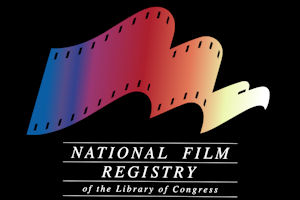There are several ways to commemorate the best motion pictures. Obviously, the big ones are prestigious honors like the Academy Awards and the Golden Globe Awards. Then you have smaller means of film recognition, such as film critics' lists of best movies in a given year. Along those lines, I like the American Film Institute's annual list of the 10 best movies of the year, not to mention its choices for the 10 best television programs of the year. But there's another recognition for film that isn't talked about as widely, but it's still there for enthusiastic film buffs to notice: the National Film Registry.
What is that, you may ask? Well, it's basically a film archive managed by the federal government of the United States, specifically the Library of Congress. Think of it as a time capsule for American motion pictures, one that represents the evolution of American film and its artistic mastery. It's summed up by the phrase "culturally, historically, or aesthetically significant." Those are the types of movies that go in this archive. They don't have to be huge critical and box office successes. They just have to be representative of American film. I first discovered the National Film Registry when I read about classic movies I enjoyed, because I would often see that the film was added to the National Film Registry for being culturally, historically, or aesthetically significant. My curiosity led me to look up information about the Registry.
And now I am here to share my appreciation of it with you, in hopes of getting you to also delight in what it has to offer.
A Brief History of the National Film Registry
The story begins in 1988, when the United States government passed the National Film Preservation Act, a set of laws that, among other actions, directs the Librarian of Congress to establish the National Film Preservation Board and the National Film Registry. The Board's job is to select 25 films to add to the Registry each year, in order to preserve the heritage of American film. The criteria for induction into the Registry is simple: any film at least 10 years old that is culturally, historically, or aesthetically significant. As for the members of the National Film Preservation Board, they comprise people who represent the different aspects of the motion picture industry, such as those who are members of the Academy of Motion Picture Arts and Sciences, the Motion Picture Association of America, and the National Society of Film Critics. It's quite a diverse body of people who are experts in film. Interestingly, starting in 1997, anyone in the public outside the Board can suggest up to 50 films a year for Registry consideration, though the Board still makes the final decision about which 25 films to induct.
This has been an annual tradition since 1989. With 25 films archived per year for 29 years, the National Film Registry has added 725 films as of the end of 2017. And thanks to several renewals of the National Film Preservation Act, including the most recent in 2016, we can expect to see more films archived in the coming years. As for what types of films are in the list, well, there's a wide variety. I obviously cannot detail every film in the Registry, and even if I were to just stick with the films in the Registry that I myself have seen, it would be too many to go through. But I can at least provide an overview of some of the major titles in it, each related to a different aspect of American movie history.
So let's take a look at what the Registry has in store...
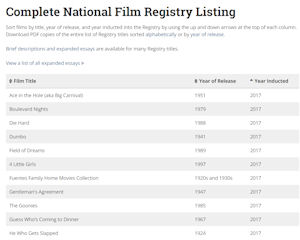
Movie History in a Nutshell: Golden Age Classics
If you want to archive American films, there's no doubt that you'll want to archive the classic ones. Obviously, there are a lot of films that are considered classics. Even if you limit it to those from the first half of the 20th century, you'll have a bunch to put in the archive.
Skimming the list, I am not surprised to see the 1941 film Citizen Kane in the Registry, considered by many to be the greatest American film of all time. The archive also has other cinematic greats from the same decade, including four Humphrey Bogart movies:
Casablanca,
The Maltese Falcon,
The Big Sleep, and
The Treasure of the Sierra Madre.

Of course, don't forget the preceding decades. For example, one 1930s American classic is the timeless
Gone With the Wind. There's also
The Adventures of Robin Hood. Again, I am not trying to provide a complete list, but rather just a sample. Hopefully, this gives you an idea of what the Registry is willing to archive for all time.
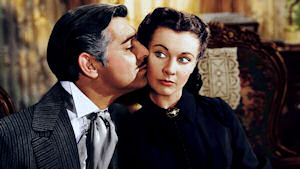
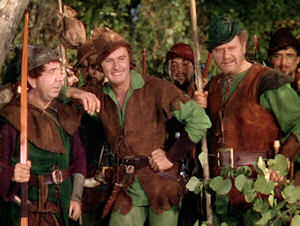
Movie History in a Nutshell: Silent Films
One major purpose of the National Film Registry is to showcase the history of films, so it is expected that the earliest films, around the birth of motion pictures, are archived as well. This means there are silent films to be found in the Registry. There are two examples of silent films in the Registry that showcase film editing techniques at the time. One is the 1903 short film The Great Train Robbery, which presents each scene of the story as a long continuous shot from a stationary camera. The other notable silent film, twelve years later, is
The Birth of a Nation, which essentially pioneered editing techniques that allow the film to switch camera angles as an aid in storytelling.
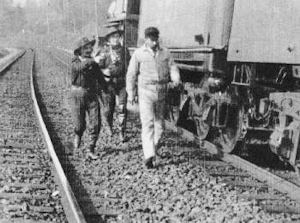
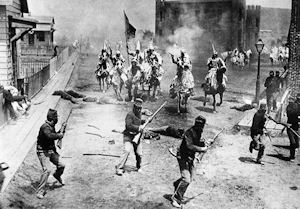
Let's not forget that silent films also showcased a few big stars. Two may come to mind for many: Buster Keaton and Charlie Chaplin. Pictured below are stills from the Keaton film The General and the Chaplin film The Kid, both preserved in the National Film Registry.

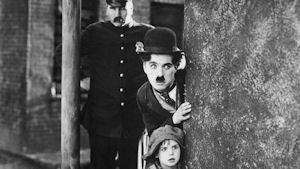
Movie History in a Nutshell: Alfred Hitchcock
Alfred Hitchcock is called the Master of Suspense for good reason. He directs films that make the audience hold their breath and wonder what is the next thing that will happen. He is so good at it that it's no surprise the National Film Registry has archived several of his major works, including
Notorious,
Rear Window,
Vertigo,
North by Northwest,
Psycho, and The Birds.
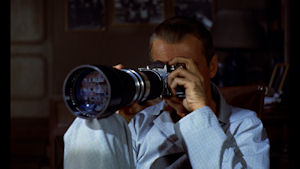
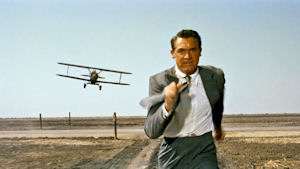

Movie History in a Nutshell: Animation
Another type of film that appeared in the early history of motion pictures is animation. One name no doubt comes to mind for many people: Walt Disney. In 1928, he created the animated short Steamboat Willie, which introduced the world to Mickey Mouse. It was also notable for the way it played sound that was synchronized with the animation. No doubt it's a technical milestone and one that deserves to be archived.
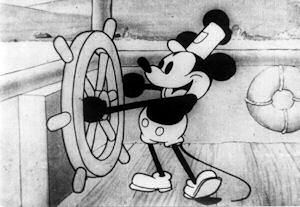
The Disney animation studio would go on to produce many feature-length animated films. Undoubtedly, the first one is in the National Film Registry:
Snow White and the Seven Dwarfs. Since then, many Disney animated films would follow. Fantasia and Bambi are two more examples, both of which are in the Registry. Another is
Beauty and the Beast in 1991, which was remarkable for being the first animated film to be nominated for the Academy Award for Best Picture. That certainly makes it worth being archived in the Registry. Eventually, another Disney animated film made it into the Registry:
The Lion King. I agree with archiving The Lion King because it has emotional power as well as great music.
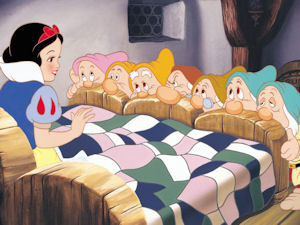
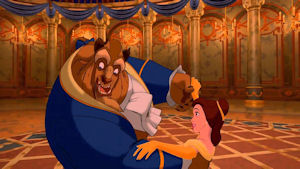
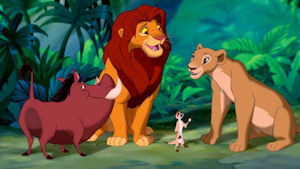
Besides Disney, another company would impress the world with animation. Pixar emerged as a leader in computer animation, starting with various 3D animated shorts. Hence, the first of those shorts, Luxo Jr., has been added to the Registry. Same for another Pixar short, Tin Toy. And with the establishment of computer animation as a medium for feature-length film, it is fitting that the first-ever feature-length computer animated film,
Toy Story, is now archived in the National Film Registry for all time.
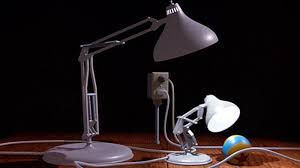
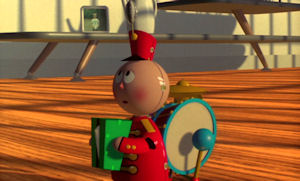
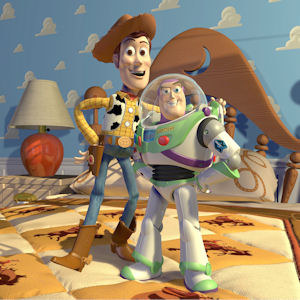
This is a good time to mention one film in the Registry notable for integrating animation and live action:
Who Framed Roger Rabbit. Given how incredibly innovative it was at the time, how could one NOT archive this movie?
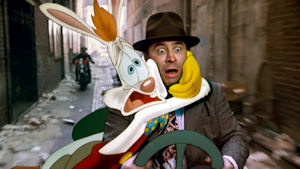
Movie History in a Nutshell: Pop Culture with Special Effects
One thing I love about the Registry is how it doesn't heavily favor certain types of films over others. It's a criticism one might have about the Academy Awards giving honors to artsy or serious films instead of pop culture entertainment. That said, it's nice to see films in the Registry that are considered pop culture. For example, there are movies that are quite notable for the special effects featured.
Let's start with this early example:
King Kong. This 1933 film is remarkable for stop-motion animation that brings to life a few large creatures on Skull Island, including Kong himself. And who can forget the climactic action in New York City, with the beast climbing the Empire State Building and fending off the airplanes shooting at him? A movie with these kinds of visuals in its cinematic era deserves a spot in the Registry.
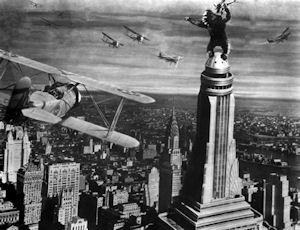
Over time, special effects would make their way into films in interesting ways. For example, The Ten Commandments in 1956 features the famous scene with Moses parting the Red Sea, and it's not surprising to see it in the National Film Registry. Also, in the 1970s, a filmmaker named Steven Spielberg would create two films that have great special effects for their time and are now in the Registry: the shark thriller
Jaws and the sci-fi film
Close Encounters of the Third Kind.

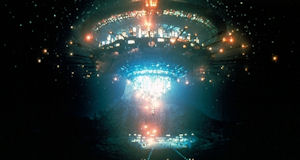
And around the same time, another emerging filmmaker would make his mark: George Lucas. There is absolutely no doubt that his 1977 sci-fi adventure
Star Wars deserves to be in the archive. Its special effects are, even to this day, just incredible to see. And the film would launch one of the biggest movie franchises ever. And if that's not enough, it's sequel,
The Empire Strikes Back, would also be inducted into the Registry. This is a great honor, because it's an example of a movie sequel that tops the original in stunning fashion.

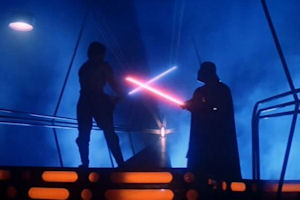
And to wrap up this section of my commentary on the National Film Registry, here's a more recent film with big-budget special effects that got inducted:
Titanic. James Cameron's 1997 epic hybrid of a romance and disaster movie was a huge success, with both the box office and critics. I am glad to see it in the list.

Movie History in a Nutshell: Action Movies
You know what's another genre of movies that don't get enough consideration for major film awards but are nevertheless a big part of American culture? Action movies. It's such a major genre that it has multiple subgenres. There's action thriller, action comedy, cop action movies, sci-fi action movies, and a bunch more. So if you had to pick a few films that represent the best or the most groundbreaking of the genre, which would you pick? Obviously, the answer depends on who you ask. Since we're talking about the National Film Registry, let's see what action movies the Library of Congress added to the list.
Scanning the Registry, I see a few action films from the 1970s that represent different action subgenres. One is the 1973 Bruce Lee movie
Enter the Dragon. In Lee's relatively short film career, he had starred in two Chinese martial arts films,
The Big Boss and
Fist of Fury, played the role of Kato on the television series The Green Hornet, and starred in Enter the Dragon, which is an American film released by Warner Bros. So of these works, the obvious choice for archiving and immortalizing Bruce Lee in the Registry is Enter the Dragon. It's a good film, not the greatest, but it represents American interest in martial arts action.
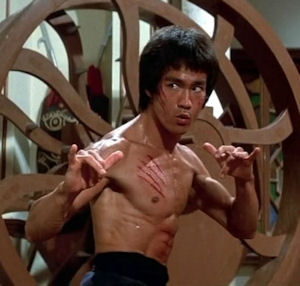
Another 1970s action movie I saw in the Registry:
Dirty Harry. This is a good choice for the list. Not only is it a notable cop action drama. It's also a film that represents one of Clint Eastwood's best known acting roles. After all, this movie has one well-known line: "Do I feel lucky? Well, do ya, punk?" You may also know about the other familiar line from the Dirty Harry character in the 1983 sequel Sudden Force: "Go ahead. Make my day." Sudden Force is not in the Registry, but that's OK. The point of the list is to present representative films, so the first Dirty Harry movie should suffice.
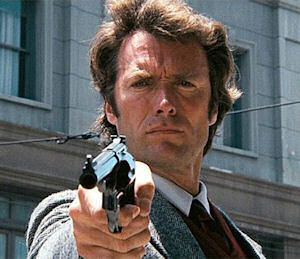
Before I forget, here's a quick honorable mention of another 1970s film in the Registry: Superman, starring Christopher Reeve.

Now let's move to the 1980s. There are three action films from that decade that I noticed have been inducted into the National Film Registry: one added after the first 10 years of the Registry's existence, and another two added in the last 10 years. The first of those three is something that highlights two filmmakers plus a big-name American actor. I'm talking about
Raiders of the Lost Ark, the first Indiana Jones adventure starring Harrison Ford, written and produced by George Lucas, and directed by Steven Spielberg. What can I say? This movie has great action and excitement, and both Harrison Ford and Indiana Jones have become solidified into American pop culture. Fans of this movie should be glad to have it recognized as a Registry entry.
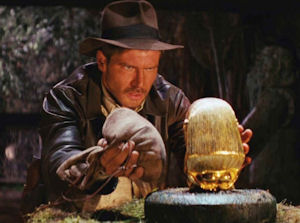
You know who else became a big action movie star sometime in the early 1980s? Arnold Schwarzenegger. His role as the title character of
The Terminator in 1984 is an unforgettable one. He is big, cold, ruthless, and deadly. The character certainly left a mark on audiences. Also, this is a sci-fi film with an interesting take on time travel, with its use by autonomous killing machines to change the past and ensure its future as an unstoppable force.
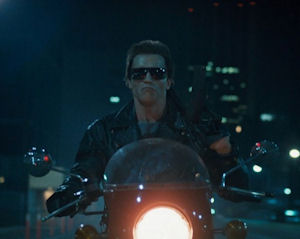
And now we get to the third notable Registry-inducted movie of the 1980s:
Die Hard. To be honest, I never predicted that this one would make the cut. But now that it has, I am very glad to hear about it. It was added to the National Film Registry just last year, in 2017, twenty-nine years after its original theatrical release. That's plenty of time for audiences across America to hail it as a classic in the action genre. If you haven't seen it, it's a lot of fun, and Bruce Willis as John McClane and Alan Rickman as Hans Gruber are fantastic.
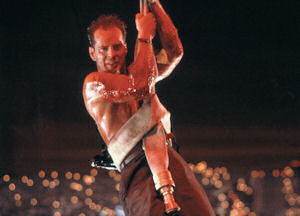
And to wrap up this section,
The Matrix from 1999, with its eye-popping special effects, is in the Registry, too.
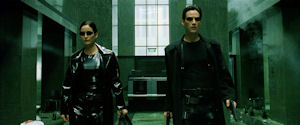
Movie History in a Nutshell: War Films
America has been associated with motion pictures throughout the 20th century. You know what else America was associated with throughout the 20th century? Wars. You've got World War I, World War II, the Korean War, the Vietnam War, and the Persian Gulf War (if you want to include major conflicts without combat, go ahead and throw the Cold War in there, too). Naturally, you can expect American films made about wars such as these. So now let me highlight the war films I see listed in the National Film Registry. Keep in mind that this is not a full list of war movies on the list. Rather, it's the ones on the list that I also have seen myself.
First up, we have the 1957 war classic
The Bridge on the River Kwai. This is a film related to World War II, specifically the British and the Japanese. It takes place in a POW camp where British prisoners of war are held captive by the Japanese. The prisoners are used as slave labor, and the next thing the Japanese want built is a bridge over the River Kwai. What makes this film an extraordinary classic is how it takes an unexpected turn towards a peaceful relationship between the two sides. The British could sabotage the bridge and make it structurally unsound, but their leader played by Alec Guinness decides that the honorable thing to do is to build a solid bridge, to show British pride in their work. Over time, a partnership forms between the British and the Japanese, and everyone forgets the master-slave relationship that existed earlier. How the film ultimately ends will leave you feeling emotional.
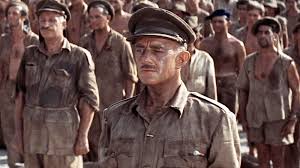
Over a decade later, the war comedy film
MASH was released in 1970. It's a way for one to attempt to laugh and smile in the face of war (in this case, the Korean War). Honestly, it's not one of my favorite war films despite the fact that so many other people love it, but I can appreciate that it deserves a spot in the Registry.
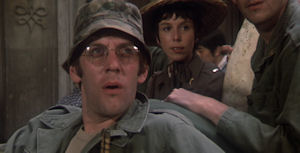
Now here's one that is definitely powerful.
Apocalypse Now takes audiences into the hell that is the Vietnam War. It's not so much about fighting and surviving combat than about searching for one colonel who has gone AWOL, possibly due to insanity. In fact, the story in this film is essentially a Vietnam War version of Joseph Conrad's classic story Heart of Darkness. The journey of the main character, played by Martin Sheen, in search of Colonel Kurtz is a memorable one, but it's the face-to-face encounter with Kurtz that will really leave chills down one's spine. Marlon Brando's performance as Kurtz is brilliant.
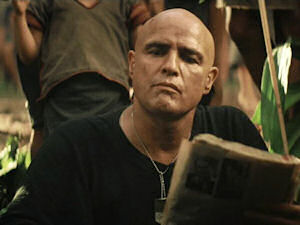
To wrap up this section on war films in the National Film Registry, I shall highlight the war film from the late 1990s that received so much critical acclaim as well as several major film awards:
Saving Private Ryan. This is a film that is definitely powerful. Its depiction of combat violence is intense, especially with the D-Day scene. It is also an unforgettable quest to save one man trapped behind enemy lines. When you look at the film as a whole, you can see how it represents the two major aspects of war: survival and sacrifice. I could go on and on, but I'm sure others can add further insights into Saving Private Ryan.
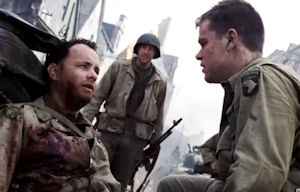
Movie History in a Nutshell: Crime Drama
Crime films are also a big part of the history of American cinema. Just as war films depict real-life American war, crime films are a reflection of crime in America over the years. I already mentioned a few crime films in the other categories above, including The Big Sleep and The Maltese Falcon in the 1940s and Dirty Harry in the 1970s. Here are two other examples of American crime films: The Public Enemy in 1931 and Scarface in 1932. I have not seen these films, but I have read that they are notable early American gangster films. Films like that certainly deserve a place in the National Film Registry.
Fast forward three decades, you'll notice another Registry-inducted crime film.
Bonnie and Clyde in 1967 is notable for the performances of stars Warren Beatty and Faye Dunaway, its inspiration from the real-life Bonnie and Clyde during the Great Depression, and the on-screen violence that pushed the limits at the time. A couple of years later, Francis Ford Coppola would direct two great crime films, both part of one series.
The Godfather as well as
The Godfather: Part II are powerful dramas about life and survival among members of the Corleone crime family, including Vito and Michael. Then there's the bank robbery drama
Dog Day Afternoon, also very powerful. If you have seen these films, you'd be hard-pressed to make an argument against adding them to the National Film Registry.
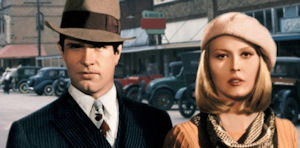
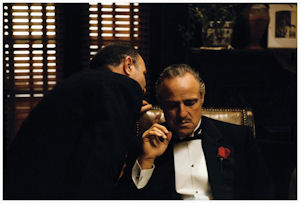
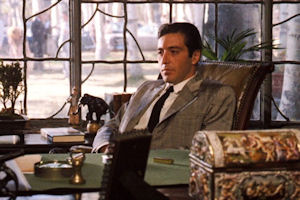
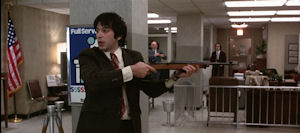
If you look through the complete film registry, you could find more films in the crime genre, like The French Connection, Goodfellas,
Pulp Fiction, and
The Silence of the Lambs. Remember, scanning the Registry, with hundreds of films and growing, can be fun because you get to see the most notable films, whether notable overall or notable in specific genres.
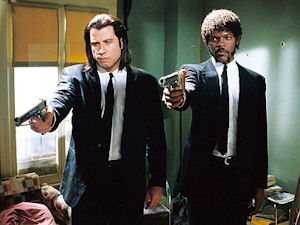
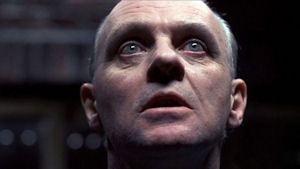
Movie History in a Nutshell: Other Dramas
There are other drama films in the National Film Registry that don't fit into the major categories I mentioned so far. I thought I'd take a moment to highlight some of them, to further show how diverse the films in the list are. There's the 1957 courtroom drama
12 Angry Men, plus the 1969 motorcycle drama
Easy Rider that is notable for its representation of the motorcycle and counterculture segments of America. If you like boxing, you'll be pleased that Rocky is part of the National Film Registry. And the politically-oriented journalism drama
All the President's Men tells the story of the investigation into Watergate. Then there's
Saturday Night Fever, which represents the 1970s disco era. The high school drama
The Breakfast Club is a memorable and heartwarming film about teen angst and looking past stereotypes to discover true friendship, in addition to being a snapshot of adolescence in the 1980s. And if you want great historical drama, check out
Dances With Wolves.
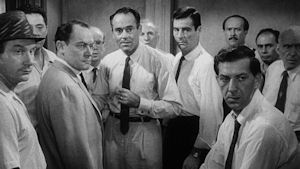
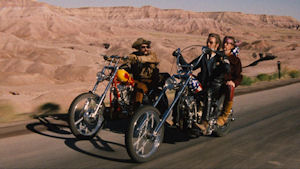

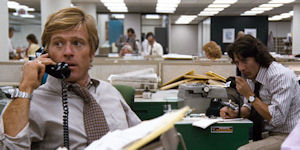
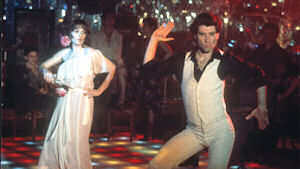
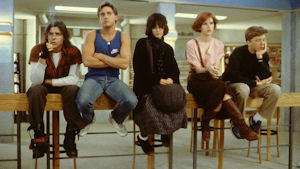
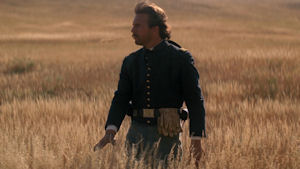
Movie History in a Nutshell: Horror Movies
Before I forget, I should cover another major film genre that has entries in the Registry: horror. I see films in the list that come from two major eras of cinematic horror.
From the early classic era of motion pictures, two films from 1931 are adaptations of classic horror novels from the 19th century. One is
Dracula, starring Bela Lugosi as the titular vampire from Bram Stoker's novel. The other is Frankenstein, with Boris Karloff as the dead being brought to life in Mary Shelley's novel. The portrayals of these characters are truly iconic, leaving a lasting impression of them in the minds of many. Anytime someone mentions Dracula or Frankenstein, it's likely that one will think of images from these films. It's also worth noting that the movie Frankenstein made one change from the Shelley novel: Frankenstein was originally the name of the scientist reanimating the monster, but the movie calls the monster Frankenstein, which has stuck in pop culture since. Oh, and the follow-up movie The Bride of Frankenstein is also in the National Film Registry.


Then there's the modern era of horror that is more graphic and intense. Three films from the 1970s are memorable for intense shock value. In 1973, audiences were treated to one of the scariest movies ever:
The Exorcist, centering on a girl who is possessed by the devil and forced to do many horrifying things. Another film from the same decade is a major entry in the subgenre of slasher films: Halloween, starring Jamie Lee Curtis as the heroine up against serial killer Michael Myers. Speaking of strong women in horror, there's another good example of it that is listed in the Registry:
Alien, a sci-fi horror film featuring Sigourney Weaver as a tough female lead battling a vicious alien creature.
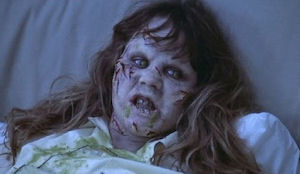


Movie History in a Nutshell: Science-Fiction
I mentioned a couple of Registry-inducted science-fiction movies already, like Alien, Star Wars, Close Encounters of the Third Kind, and The Terminator. But there are more sci-fi films listed in the Registry. So real quick, here are some of them:
The Day the Earth Stood Still,
Planet of the Apes, 2001: A Space Odyssey,
Blade Runner, and Back to the Future.
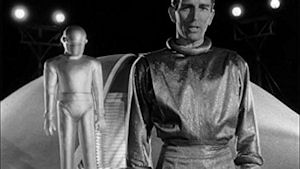
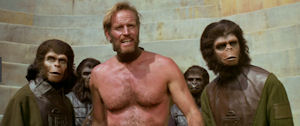


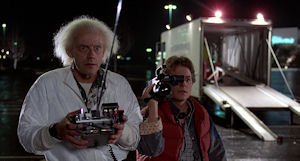
Movie History in a Nutshell: Documentaries
If you enjoy something cinematic but also nonfiction, documentaries are for you. You'll also be happy to know that the genre is represented in the National Film Registry. Looking through the list, I see two films that represent what documentaries can do.
In 1989, filmmaker Michael Moore made and released his first feature-length documentary film, Roger and Me. It presents Moore's narrative of what happened to his hometown of Flint, Michigan after Roger Smith, the CEO of General Motors, moved the company's auto manufacturing plants to Mexico, leading to socioeconomic decline and a rise in crime in Flint. Over the years, Moore would be known as a documentary filmmaker with a liberal slant in his films. Whether one agrees or disagrees with his views, one cannot deny that his style of filmmaking is unique. So it's natural to archive his first film as a representation of documentary with a political purpose.
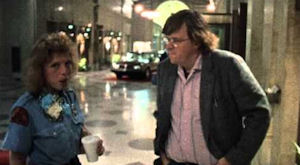
Now, if you want a documentary that is more of a straightforward capture of life as it happens, look no further than the 1994 film
Hoop Dreams. Centering on two African-American high school boys in Chicago who dream of becoming professional basketball players in the NBA, the film actually ends up being a wonderful chronicle of everyday life, from the struggles of living in poverty to the joys of high school basketball. The Library of Congress was wise to induct Hoop Dreams into the National Film Registry.

Movie History in a Nutshell: African-American Cinema
As long as we're on the topic of African-Americans, I might as well talk about African-American cinema and its representation in the National Film Registry.
Black actors and actresses can be seen in some early American films, though they're not widely represented. The only notable presence from that era I can think of is Hattie McDaniel in Gone With the Wind, only because she was the first African-American to win an Academy Award. Anyone looking for the point in American film history when blacks truly became a big part of cinema would need to look no further than the 1970s. This was the era of blaxploitation films, featuring African-Americans for mainly an African-American audience. The National Film Registry has inducted the blaxploitation film
Shaft. Whether or not one enjoys these types of films, Shaft is a major title coming out of this ethnic film subgenre.

Of course, black cinema isn't always about fun and games. Given real-life issues involving the African-American community, such as poverty, crime, racism, and the rise of hip-hop culture, it's not surprising to eventually see African-American films that are more serious in nature. The National Film Registry includes one great example of this. The 1989 film
Do the Right Thing, directed by Spike Lee, is a raw hard-hitting presentation of racial tension building up and eventually exploding in a section of Brooklyn in New York. Its presence in the Registry represents excellence in African-American drama as well as an artistic masterpiece from Spike Lee. And while I'm at it, the Registry also archived Spike Lee's 1992 biopic
Malcolm X, another film that can be called culturally, historically, and aesthetically significant.

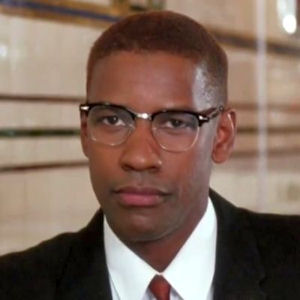
Another type of African-American drama film you might see is one that centers on street gangs, hip-hop, and life in an urban ghetto (often referred to as "the hood"). Outside of films, one real-life location that has had a reputation for such things is South Central Los Angeles (which would later be renamed South Los Angeles to avoid the negative connotation of "South Central"), where the rivalry between two street gangs, the Bloods and the Crips, has made the area a dangerous place to be. This is the setting of John Singleton's 1991 film
Boyz N the Hood, the story of three friends in South Central L.A.: the young Trey who has a father figure in his life, the ambitious Ricky who looks to have a good future, and the troubled Doughboy who still chooses to live by the code of the streets. The film is, certainly, culturally significant for its portrayal of urban African-American life.
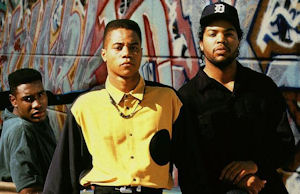
Movie History in a Nutshell: Latin-American Cinema
Another ethnic group portrayed in American film is the Latino community. Thus far, I spot two films in the National Film Registry related to Latin-American cinema.
The 1983 film El Norte is a drama about the struggles of undocumented immigrants in America. It centers on two people, Rosa and Enrique, who flee Guatemala, travel through Mexico, and enter the United States illegally through an underground tunnel. Besides being a well-received film, El Norte is significant in that it portrays the all-too-familiar ongoing issue of immigration from Central America into the U.S., particularly illegal immigration. So it's another example of a film that is culturally significant (and significant historically and aesthetically, too).
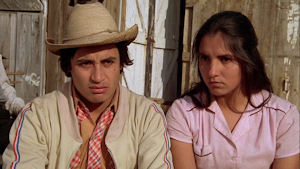
The other Latin-American film in the Registry is something more fun. Robert Rodriguez makes his debut as a director with the 1992 action crime drama film
El Mariachi. It centers on a guitar player who is mistaken for a violent criminal because the latter carries his weapons in a guitar case. The film is an entertaining spectacle, and it's amazing that the production budget was a little over $7,000, before Columbia Pictures decided to finance its post-production and marketing for the American film audience. It's also a representation of drug cartels in Mexico, another real-life issue that the Latin-American community is often familiar with.
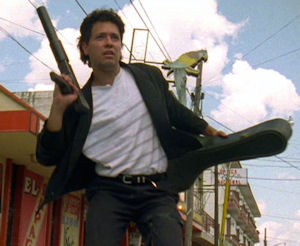
Movie History in a Nutshell: Comedy
Comedy is another major film genre and one that has existed since the beginning of motion pictures. Naturally, there are plenty of comedies listed in the National Film Registry. Here are some of the titles I recognize, which I'm mostly race through.
Some early 20th-century comedies in the list include My Man Godfrey, Duck Soup, and
Abbott and Costello Meet Frankenstein. Then there's the classic cross-dressing comedy
Some Like It Hot. Later, a great satirical film in 1964 would emerge as a classic.
Dr. Strangelove or: How I Learned to Stop Worrying and Love the Bomb is a hilarious jab at the otherwise all-too-serious threat of a nuclear holocaust. All of the characters are funny, though Peter Sellers playing not one or two but THREE characters steals the show, especially as the titular Dr. Strangelove.
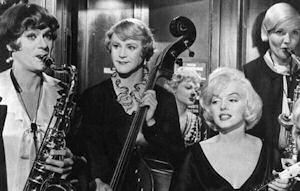

In the late 60s and early 70s, director Mel Brooks emerged as a brilliant comedy filmmaker. Three of his earliest films are now in the National Film Registry:
The Producers,
Blazing Saddles, and
Young Frankenstein. These three also feature the late Gene Wilder.
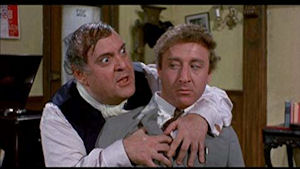
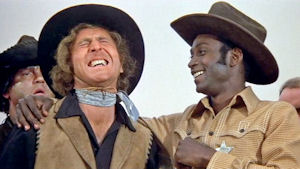
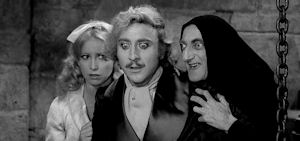
In the early 1970s, George Lucas made the teen comedy
American Graffiti. Then, in the late 1970s,
National Lampoon's Animal House set the standard for comedies with raunchy humor, often related to sex, gross-out jokes, and juvenile behavior. In 1980,
Airplane! presented a unique style of comedy involving nonsensical sight gags for laughs, with the plot being just a backdrop for the jokes. Other comedies from the 1980s that are in the Registry include
Ghostbusters, the mockumentary
This Is Spinal Tap, and Ferris Bueller's Day Off.
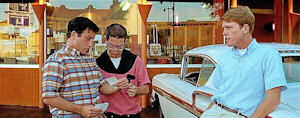
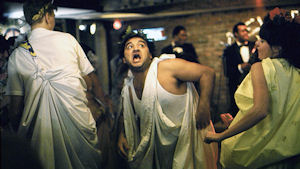


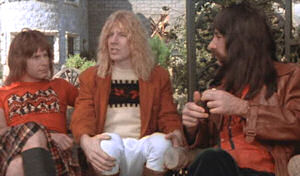

Movie History in a Nutshell: Musicals
Motion pictures started out as silent films because the technology for recording and playing back sound with film had not yet been discovered and implemented. Once that occurred, the world of movies opened up. It certainly made it possible for musical films to be made, featuring audible songs and music in addition to the visuals that often featured dance numbers. Here's a sample of the musicals inducted into the National Film Registry.
First off, there's
The Wizard of Oz, Singin' in the Rain, and
West Side Story.
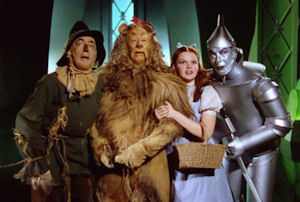
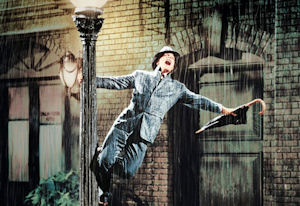
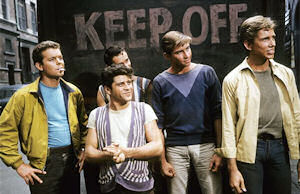
And here are two musicals starring Julie Andrews:
Mary Poppins and The Sound of Music. Plus, Gene Wilder in
Willy Wonka and the Chocolate Factory.
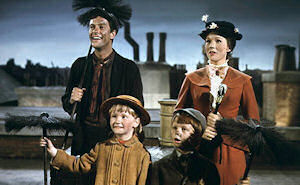
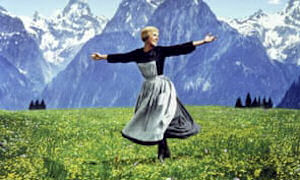
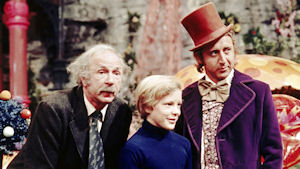
Movie History in a Nutshell: Romance
Love stories have been around for a long time, even well before the age of films. There are a couple of romance films in the National Film Registry, some of which I already mentioned, like Casablanca and the Disney animated Beauty and the Beast. For the sake of moving things along, I'm only going to mention three more examples of Registry-inducted romance films, all starring Audrey Hepburn: Roman Holiday,
Sabrina, and
Breakfast at Tiffany's.


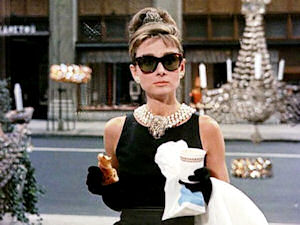
Other Film History: Historical Documentary Footage
Now let's take a look at the films in the National Film Registry that are not feature-length theatrically-released movies. The archive is intended to showcase the history of film, but it doesn't have to be limited to the kind you watch in theaters or on home video. To me, that makes the Registry even more fascinating. You can have pretty much anything in the National Film Registry as long as it is on film and it is culturally, historically, or aesthetically significant. That includes incredible historical footage.
For example, the Registry includes two pieces of historical footage from San Francisco in the year 1906. One is called A Trip Down Market Street. This is footage taken of Market Street in downtown San Francisco from a cable car moving forward along its tracks, northeast towards the San Francisco Ferry Building. It's several minutes long, but you can observe plenty of things, like the buildings on either side of Market Street, horse carriages and automobiles moving about, cable cars moving in the opposite direction, and various pedestrians. The other footage is titled San Francisco Earthquake and Fire, April 18, 1906. It presents the aftermath of the San Francisco earthquake of 1906, with images of things like destroyed buildings, people standing near rubble, and crowds moving about, interspersed with text cards to explain what is being shown. The fact that both pieces of footage are over 100 years old and still around for us to see is incredible. They are truly pieces of history, and are appropriately archived in the National Film Registry.
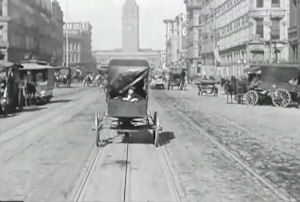
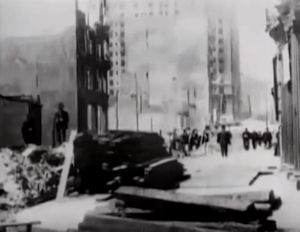
Speaking of disasters like the San Francisco earthquake, the Registry also has archived two other pieces of historical documentary footage related to disastrous events. There's the 1937 Hindenburg disaster newsreel footage, capturing the flight of the Hindenburg airship, the moment it caught fire, its destruction midair and on the ground, and the actions of first responders. There's also the Zapruder film, which is Abraham Zapruder's home-video capture of the assassination of U.S. President John F. Kennedy in Dallas, Texas on November 22, 1963. In both cases, the footage is a way to remember those who have died and to analyze the events more closely. They are certainly historically significant.
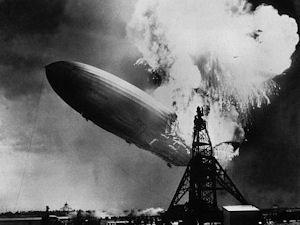
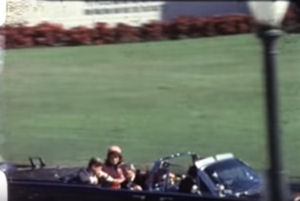
Other Film History: Educational Film
Besides looking through the Registry for films I am familiar with, I spent some time looking at titles of films in the Registry that I never heard of. In doing so, I came across a type of film that can be archived, though I found only one such entry as an example. I was curious when I noticed a 1946 film called The Story of Menstruation. Looking into it further, I was not surprised that it's an educational film about the process of menstruation. What did surprise me, however, was the fact that Walt Disney Productions made the film. Given the family-oriented nature of the animation studio, it's not surprising that The Story of Menstruation does not go into female reproduction or sexuality. Overall, I think it's great the Registry is archiving something like this, and I look forward to seeing more educational films added to the list.
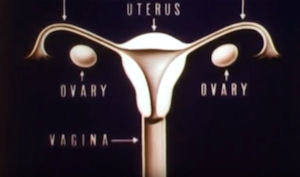
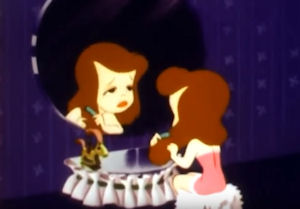
Other Film History: Music Video
The last thing I shall talk about regarding the entries in the National Film Registry is a type of film that has been archived for the first time just recently: the music video. This is something that has existed for a few decades, particularly after the 1981 launch of the cable channel MTV (Music Television), but the National Film Registry would not archive the first modern music video until the year 2009, when the Library of Congress officially archived Michael Jackson's Thriller music video. I think it's a brilliant choice. There may be a ton of music videos to pick from, but it is most sensible to select an early video that would influence so many others and continue to entertain for many years after its release. The music video for the Michael Jackson song Thriller, with its memorable dance choreography, eye-popping scary costumes, and great music, fits the bill. I'm glad it is in the Registry.
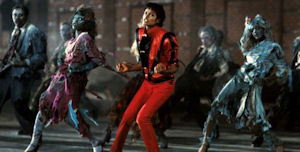
My Nominations for 2018
For years, I knew about the National Film Registry and what it does, but I always assumed that the process of nominating films to consider for induction into the Registry was limited to a group of insiders. Then I learned that, since 1997, members of the public have the opportunity to nominate up to 50 films per year for the National Film Registry. You can do so by filling out an online form at the National Film Registry website, or do it the old-fashioned way by mailing in your suggestions. Once I learned about this just months ago, I decided to give it a try myself.
I spent some time reviewing the films already in the Registry and figuring out what makes each one special enough to be inducted. I kept in mind the phrase "culturally, historically, or aesthetically significant." Then I looked at films I know that are not in the Registry. In doing so, I can see plenty of films that deserve to be in the list but have not yet been chosen. When I say plenty, I don't mean a small handful. I mean enough to be able to fully complete the online submission form, with 50 film suggestions.
With that, here are the 50 films that I have nominated for induction into the National Film Registry in 2018, and my rationale for each:
- Nosferatu (1922) - This one is significant as a vampire film in the silent film era. Note that the National Film Registry does not have a rule disallowing foreign films (Nosferatu is a German film), but American films are the focus of the archive. I thought I'd still give it a shot anyway.
- The Adventures of Sherlock Holmes (1939) - Sherlock Holmes is an iconic character that has entered the minds of the American public, and this film is a great representation of that.
- Inherit the Wind (1960) - This powerful drama highlights the historically significant debate of religion versus science in America.
- It's a Mad, Mad, Mad, Mad World (1963) - This movie is just too funny to not archive.
- Jason and the Argonauts (1963) - If you want to archive a film that samples stop-motion animation in the 1960s, this film is notable for it.
- Dr. Martin Luther King Jr.'s I Have a Dream Speech (1963) - The civil rights movement was and still is an important part of American history. If the Zapruder film of the JFK assassination could be archived, why not this historical footage?
- Goldfinger (1964) - James Bond may be a British character and this movie may be British, but the way it sparked interest in fictional espionage in America and abroad was incredible.
- A Clockwork Orange (1971) - This is a creative piece of work from Stanley Kubrick, and it is noteworthy for pushing the limits of acceptable content.
- Coffy (1973) - Pam Grier was a major star in 70s blaxploitation film, and this represents her notable work.
- Grease (1978) - This one highlights John Travolta's musical talent and presents a portrayal of the 1950s.
- The China Syndrome (1978) - The issue of the risks of nuclear power plants was raised with this film.
- The Shining (1980) - It's significant as a horror movie and one based on a Stephen King book.
- Star Trek II: The Wrath of Khan (1982) - Star Trek is a major American sci-fi franchise, and this film is a recognizable representation.
- Scarface (1983) - This film may be a remake of the 1932 Scarface, but it took a life of its own and stayed in the minds of audiences.
- Return of the Jedi (1983) - This wraps up the original Star Wars trilogy, one of the most successful film trilogies ever made.
- The Karate Kid (1984) - This film is a notable 80s film and is unique for portraying youth and martial arts, plus featuring Pat Morita.
- A Nightmare on Elm Street (1984) - Wes Craven made an impact in the horror film genre, certainly with this film.
- RoboCop (1987) - Here is a unique cinematic presentation of gripping dystopian science-fiction.
- Wall Street (1987) - The American financial system is a major subculture, and no other film portrays it like this one.
- Dirty Dancing (1987) - Patrick Swayze was a real star here, and some good 1980s music came out of it.
- The Naked Gun: From the Files of Police Squad! (1988) - Airplane! may be an earlier comedy with humor based on non-sequiturs, but this one took it further and really launched Leslie Nielsen's reputation as a comic actor.
- Batman (1989) - Superman got to be archived already, so why not Batman?
- Home Alone (1990) - Macaulay Culkin was a notable child star, and this is what made him famous.
- Pretty Woman (1990) - This one is unique for launching Julia Roberts's career and presenting a romance surrounding a prostitute.
- JFK (1991) - The movie, besides being incredibly well-made, is noteworthy for reminding us that people can question what people believe by convention.
- Terminator 2: Judgment Day (1991) - This is an example of a great sequel, plus it uniquely turns an established villain into a hero.
- Bram Stoker's Dracula (1992) - The character of Dracula has cinematic representation in the early 20th century, as well as the late 20th century.
- Aladdin (1992) - Along with Beauty and the Beast and The Lion King, this represents Disney animation at its peak in the early 1990s.
- The Fugitive (1993) - This one is a highlight for actor Harrison Ford, plus an example of how a remake of a TV show can work very well.
- The Joy Luck Club (1993) - This is one of the few American films made about Asian-Americans. And given how Crazy Rich Asians stimulated new interest in Asian culture in 2018, this would be a great time to archive The Joy Luck Club.
- Jurassic Park (1993) - The special effects here, bringing dinosaurs to life, were a major step forward.
- Speed (1994) - Once in a while, a simple premise is turned into nonstop thrills, and this action movie did a great job doing just that.
- Braveheart (1995) - This award-winning film showcases Mel Gibson and portrays medieval England.
- My Family, Mi Familia (1995) - Here is a powerful drama about Mexican-Americans that pays tribute to their culture.
- Wag the Dog (1998) - You don't see films of political satire often, and the issues of media and politics still resonate long after this film's release.
- South Park: Bigger, Longer, and Uncut (1999) - This is a unique animated film that also reminds us that there is such a thing as animation for adults only.
- Crouching Tiger, Hidden Dragon (2000) - Asian cinema includes stories of fantasy, martial arts, and romance, and Ang Lee's work here captures it all.
- Shrek (2001) - This animated film solidified Disney's competitor, DreamWorks, while launching two trends: pop culture satire in animation and highlighting the actors behind the voices.
- Harry Potter and the Sorcerer's Stone (2001) - The boy wizard captured the hearts and imaginations of so many worldwide.
- The Lord of the Rings: The Fellowship of the Ring (2001) - The first of Peter Jackson's take on J.R.R. Tolkien's fantasy trilogy is breathtaking in storytelling and visuals.
- Pirates of the Caribbean: The Curse of the Black Pearl (2003) - Swashbuckling pirate action is given an entertaining revival in the 21st century with this one.
- Ray (2004) - This film pays tribute to American music legend Ray Charles while launching Jamie Foxx's career into drama.
- The Passion of the Christ (2004) - If you want an unforgettable film centering on religion, here is one.
- Sin City (2005) - This film is aesthetically significant for stunning almost-colorless visuals and the use of a graphic novel as the storyboard itself.
- Borat: Cultural Learnings of America for Make Benefit Glorious Nation of Kazakhstan (2006) - No other film before this served as a mockumentary that plays jokes on real people in order to reveal American prejudices.
- United 93 (2006) - The terrorist attacks of September 11, 2001 shocked America, and this undeniably powerful film captures the emotion and heroism of that fateful day.
- Flags of Our Fathers (2006) - Clint Eastwood not only made a great war movie, but also took the unique step of making a complementary film from a different perspective.
- Letters From Iwo Jima (2006) - The reasons for the significance of this one are the same as Flags of Our Fathers.
- There Will Be Blood (2007) - If you had to archive one movie starring Daniel Day-Lewis, pick this one, which also portrays the life of an American oil tycoon.
- The Dark Knight (2008) - This represents the pinnacle of superhero movies, something that can serve as the standard for future superhero movies.
Once I submitted these 50 films as my nominations for the Registry, I realized that I could look at this as a fun little game. In December 2018, like the past several Decembers, the Library of Congress would announce the next 25 films to officially induct into the National Film Registry. How many of my 50 nominations would be among the 25 officially selected? I would feel great if even one film I nominated made it to the archive. It would be weeks before I got the news of the 2018 inductees.
The National Film Registry's 2018 Inductees
On December 12, 2018, the Library of Congress announced that it was adding the following 25 films to the National Film Registry:
- Something Good - Negro Kiss (1898)
- Dixon-Wanamaker Expedition to Crow Agency (1908)
- The Girl Without a Soul (1917)
- The Navigator (1924)
- The Informer (1935)
- Rebecca (1940)
- Leave Her to Heaven (1945)
- The Lady from Shanghai (1947)
- On the Town (1949)
- Cinderella (1950)
- Pickup on South Street (1953)
- Bad Day at Black Rock (1955)
- One-Eyed Jacks (1961)
- Days of Wine and Roses (1962)
- Hud (1963)
- My Fair Lady (1964)
- Monterey Pop (1968)
- Hearts and Minds (1974)
- The Shining (1980)
- Hair Piece: A Film for Nappy Headed People (1984)
- Broadcast News (1987)
- Jurassic Park (1993)
- Eve's Bayou (1997)
- Smoke Signals (1998)
- Brokeback Mountain (2005)
Several of these 25 additions to the Registry are films I have never heard of. However, after reading the Library of Congress's descriptions of them, I could understand their value. For example, The Lady of Shanghai is one of Orson Welles's later works in his career, and The Navigator is another Buster Keaton classic. Plus, believe it or not, a 29-second film from 1898 called Something Good - Negro Kiss features what may be the first-ever on-screen kissing scene between two African-Americans, something that many people today may not expect to hear about. Below is a screenshot from it.
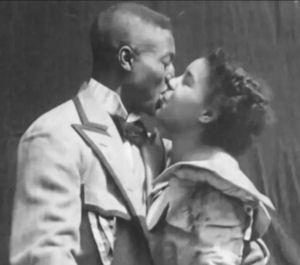
Of the inducted films I have heard of but still haven't seen, there's the 1964 musical My Fair Lady, which won the Academy Award for Best Picture that year, and the Alfred Hitchcock film Rebecca. Plus, another Disney animated film has been added to the Registry, with Cinderella from 1950. It's great these movies are being preserved for all time.
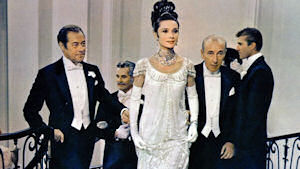

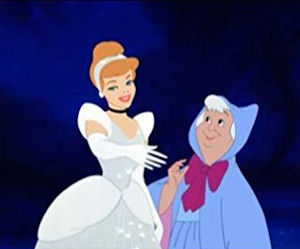
Two other films added to the National Film Registry in 2018 pertain to specific American subcultures. The 1998 film Smoke Signals, a film about young Native Americans, has the distinction of being written, produced, and directed by Native Americans. Many years later, Ang Lee directed the 2005 gay cowboy romance film Brokeback Mountain. It's a film that powerfully portrays a same-sex love relationship.
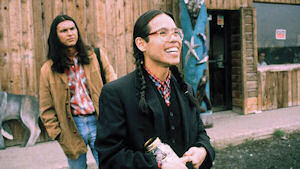
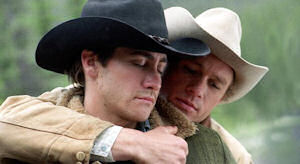
Now we get to the little game I am playing. How many of the 25 films inducted into the National Film Registry in December 2018 are among the 50 nominations I submitted months earlier? Answer: two. Considering how so many other people were also nominating films for the Registry, the fact that I nailed two of them is actually pretty good.
One of those two films is The Shining from 1980. As I said, this is a noteworthy horror film based on a Stephen King novel. And it's pretty darn scary.

The other film I nominated that got picked is Jurassic Park, which I consider significant for its special effects. What really cool is that the Library of Congress mentioned that this film got the most votes among the public this year. So apparently, a lot of people beside me nominated this movie to be added to the Registry. Way to go, everybody!
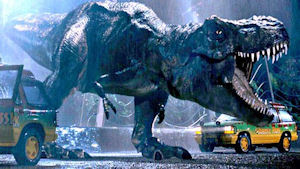
Before I forget, it's worth noting that the National Film Registry is now 30 years old, with the addition of the 2018 inductees bringing the total archive size to 750 preserved films. That is a great accomplishment. Everyone will surely celebrate future milestones as the archive continues to grow.
What Will the Registry Add in 2019 and Beyond?
Now that the 2018 National Film Registry inductees have been announced, the next question is which 25 films will be added next in 2019. There's plenty of time to think about it, but with the films that have been archived so far, we can understand and appreciate the criteria for preservation. The film just needs to be at least 10 years old and be culturally, historically, and aesthetically significant. That could mean a lot of things, so picking the best candidates is both challenging and fun. If you can identify such films, and even be able to make a clear argument for it, they have a shot at being preserved.
Speaking of which, don't forget about the public nomination form. You can complete the online or mail-in form to nominate up to 50 films. You can do it even right now. So if what I've described in this commentary about the National Film Registry has inspired you to nominate films yourself, I say go for it. As for me, I might submit the 2019 nomination form as well, just to resubmit most of my 2018 nominations because I still believe in the significance of some of them. Anyway, the Library of Congress is waiting to hear from everyone. Here's our chance to make our voices heard as movie enthusiasts. Which films will YOU nominate for induction into the National Film Registry in 2019?
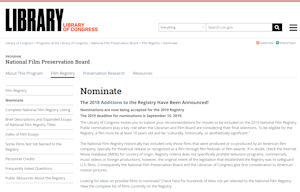
Thank You, Library of Congress
In conclusion, I would like to thank the Library of Congress and current Librarian of Congress Carla Hayden for their work in maintaining and growing the National Film Registry. Their efforts have ensured that the best and most influential films are preserved, celebrated, and never forgotten. The National Film Registry is something we can all cherish, as both a treasure trove of films and a time capsule of American culture.
